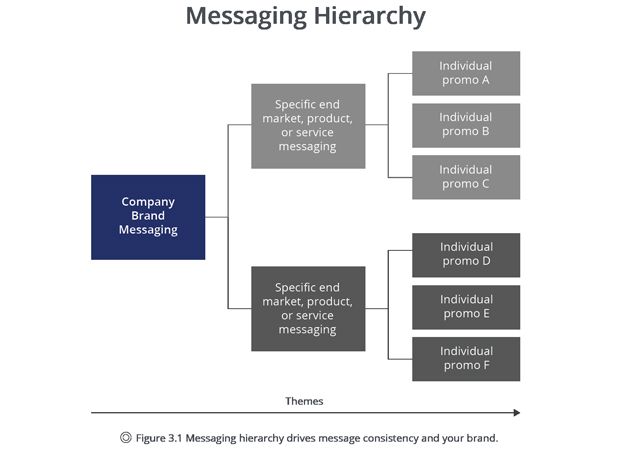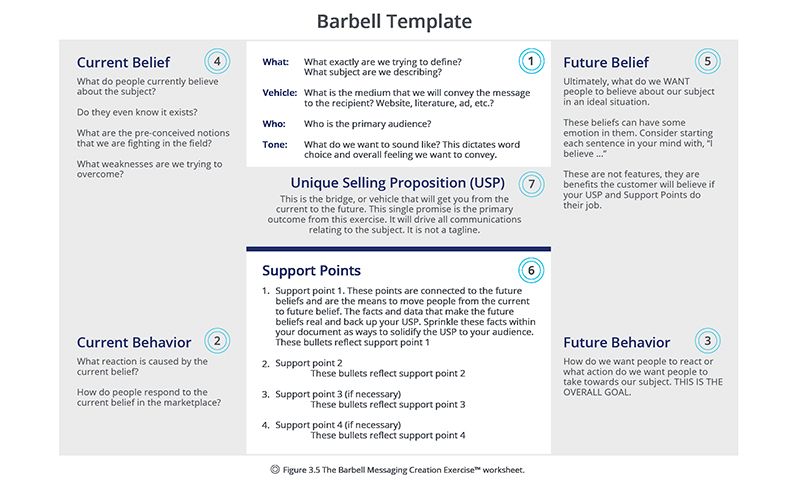To be a market leader you need excellent messaging that’s consistent and persuasive. Your messaging reflects your brand, vision, and core culture of your company. Your messaging should move your audience. Your messaging should propel your brand.
Messaging must not only be consistent in a campaign, but must also stay consistent throughout your entire messaging hierarchy.
Your messaging hierarchy starts at the corporate level where you should convey the impression of your company and its purpose. I call these foundational corporate messages Blue Statements simply to make them memorable. Some themes within the Blue Statements cascade to the next level of your messaging: product messaging and end market messaging. Elements of product and end market messaging then flow down and are used for individual marketing campaigns and collateral creation.

Creating strong messaging
There are many existing techniques to create messaging, but all have a common theme: moving the audience from a current position to a future desired position. Moving your audience to the new position could require changing an opinion, conveying knowledge, exposing a need, or sparking an emotion. Over the years, I’ve developed a method for creating message called the Barbell Message Creation Exercise™.
You develop The Barbell on a single sheet of paper or worksheet. The exercise helps you organize your thoughts and construct the strongest possible messaging. The Barbell helps you determine how best to move the audience from a current belief and behavior to a future belief and future behavior.

Your Barbell output is a unique selling proposition (USP) and three to five support points that are the facts, features or benefits supporting the USP. You can use this exercise to create all your messaging from high level Blue Statements to targeted email campaigns for a specific product or offering.
Here is a finished example of the barbell exercise for a fictitious company called ABC Custom Truck Works – a company that makes custom pickup trucks for residential and commercial landscapers.

Follow the numbered steps to see how ABC developed this messaging Barbell. Note how throughout the Barbell exercise, ABC keeps their statements concise and to the point. That’s the key to developing effective USP’s and support points.
1. Purpose of the messaging
- WHAT:
What is the topic of the messaging? Are you promoting a new high-tech product, creating messaging for an upcoming webinar, or creating an aftermarket service flyer? - WHO:
Determine your target audience. It is important to clearly identify your target audience before you begin. That sounds obvious, but I’ve seen marketers consistently miss this step and then struggle to create their piece. Your target audience might be the leads in your database, or existing customers who are seeking support options, or prospects attending a tradeshow. In addition, consider the audience’s role since messaging to the CEO is different than messaging to a purchasing agent. The more narrowly defined your target audience, the greater the chance your messaging will resonate with them. If you define your audience too generally, your message will likely not be relevant and will be drowned out by the noise of their daily onslaught of tag lines and promotions. - VEHICLE:
How are you going to deliver your messaging? Will it reach the audience via your website, an email, a print ad, or a tradeshow display? - TONE:
What tone do you want your message to have? The tone must be appropriate for the application. Depending on the application, it might be authoritative, technical, sexy, elite, strong, trustworthy or whimsical. Your tone is different if your buyer persona tends to be an engineer, as compared to an artist, small business owner, or CEO of a large firm.
2 & 3. Current behavior and future behavior
How is the target audience behaving now? How do you want them to behave in the future? Future behavior is connected to your CTA (Call to Action).
This section typically includes one concise bullet for the current and one for the future behavior. An example of a current behavior of a prospect is, “I don’t fill out the contact information form on your website.” Examples of future behavior of a prospect after your messaging has done its job are as follows. “I will fill out the contact card.” “I will call ABC company.” “I will sign up for the webinar.” In high dollar sales, you don’t want to be unrealistically aggressive by listing a future behavior like, “Buy all of my product at full price.” Think about the call to action that advances the behavior of the audience, rather than closes the sale.
4 & 5. Current belief and future belief
Current belief statements should be limited to six to 12 items and your future belief statements should answer the current belief statements. Feel free to insert emotion into these statements.
A current belief should describe the attitude of your target audience today – how they see your company and offerings and what problems they face.
Possible current beliefs about ABC Custom Truck Works include:
- I don’t know who ABC Custom Truck Works is.
- ABC is too expensive.
- A new landscaper truck can’t make my job easier.
More general current beliefs associated with the typical problems and needs of a landscaper include:
- I must keep my workers safe.
- I need to complete jobs faster.
- Idle labor reduces my profit.
- I can’t configure the truck myself.
- I must have complete reliability.
A future belief is what you want the target audience to believe after they have consumed your messaging. Developing your current and future beliefs statements requires careful thought. You are not focusing on features, but instead are looking to communicate an understanding of the benefits your product or service offers.
As you create these statements, imagine starting each phrase with “I believe…” Examples of desired future beliefs include:
- I’ll have great ROI with this truck.
- I will complete jobs faster.
- New body design will save project load time and gas.
- ABC will help me configure the flatbed properly.
- This equipment will help keep my workers safe.
- I can get high-end jobs.
- ABC vehicles are reliable.
Make sure to answer the current belief statements with your future belief statements.
6 & 7 Support points and the USP
Develop the support points and the unique selling proposition together, while constantly referencing the future belief section.
Develop three to five factual support points that reflect your future beliefs and back up your USP. Each of the support points can have sub-points if you need to explain further or provide additional detail. For example, ABC has three support points to their USP, and one of them is “You can trust ABC Custom Truck Works.” The facts that support this support point cover things like leadership, number of trucks supplied nearby, longevity of operation, and strong ROI.
The unique selling proposition, sometimes also called a unique singular promise, is a short phrase that summarizes the support points and forms the bridge between the current and future beliefs. You will be developing the USP along with the support points, shifting between both as you work to conclusion.
The more iterations you put into your USP and support points, the stronger your result. It’s common to come back to your completed Barbell the next day and refine it further. By revisiting the document, you’ll find you can shorten the phrases, clarify the intent, and delete unimportant items. The more concise your Barbell, the more useful it will be when the time comes to create marketing content.
Template for You
Here is a Barbell template download for your convenience.

Remember, your barbell output is conceptual. Up to this point, you have been creating ideas and themes from which to write copy for a specific purpose.
Your support points create an outline for the piece you are creating. These support point themes should be placed in rough order of priority. When you stand back and look at your piece, you need to also check it against your USP. Ask yourself, are you communicating verbally, visually, and emotionally the essence of the USP? Are the support points properly translated into compelling phrases, pictures, and feelings?
Going back to our ABC Truck example, the USP reads, “Complete landscaping jobs faster with the latest ABC Custom Truck.” This USP might not be appropriate text in a TV ad, but you need to find a way to incorporate the core messages. The same concept applies to the support points. Your barbell has generated marketing ideas and you now must tailor these ideas to match the needs of your specific content.
Using the Barbell Message Creation Exercise will help you improve your messaging. You will get the best results by working with a team rather than conducting the exercise alone. Don’t be discouraged if you find it a little bit difficult at first. The exercise takes some practice but the output is well worth it.
Try it out and let me know how it goes.
Latest posts by Chip Burnham (see all)
- Value Pricing Retains Both Customers and Profits - November 14, 2018
- Voice of the Customer – Needs Research - October 17, 2018
